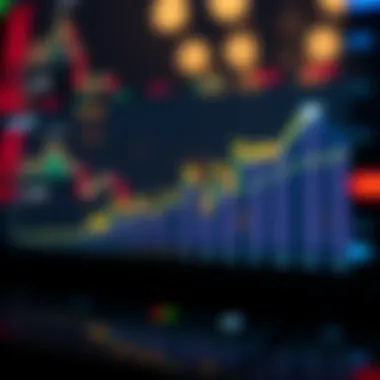Understanding Currency Trading Volume: Key Insights


Intro
In the bustling landscape of financial markets, understanding currency trading volume plays a pivotal role in shaping informed investment decisions. Volume, as it relates to currency trading, encapsulates the total number of units exchanged over a set period, acting as a bellwether for market sentiment and price movements. Currency trading isn't just about buying low and selling high; it involves deciphering a myriad of market signals, one of the most prominent being trading volume. This article seeks to explore the dynamics and implications of trading volume in the currency market, particularly in the burgeoning world of cryptocurrencies.
As we navigate through this topic, we will highlight how trading volume influences price fluctuations, the historical context that has shaped current trends, and various methodologies to analyze these volumes effectively. By understanding these elements, traders and investors can better anticipate market movements, enhancing their strategies and outcomes.
Understanding Cryptocurrency Market Trends
Current Market Analysis
The current state of the cryptocurrency market is characterized by volatility and rapid changes in trading volume. As of late 2023, platforms like Binance and Coinbase have seen significant fluctuations in daily trading volume, which is often a reflection of broader investor sentiment. When Bitcoin or Ethereum experiences a surge in trading volume, it indicates a potential price shift, whether bullish or bearish.
Before diving into the specifics, it’s crucial to contextualize trading volume by observing the broader market conditions. In most cases, a dramatic increase in volume precedes significant price movements. Investors should remain vigilant, monitoring volume spikes in tandem with major news events or changes in regulation that might affect market dynamics.
Historical Performance and Lessons Learned
Looking back, historical data reveals striking patterns in how trading volume correlates with price outcomes. Take, for example, the 2017 Bitcoin bull run. The monumental price increase was supported by unprecedented trading volume. Conversely, periods of stagnation often saw diminished volume, signaling waning interest. This historical lens not only emphasizes the importance of analyzing volume but also provides critical lessons for future trading strategies.
Understanding these past trends can arm traders with insights necessary to anticipate market behaviors. It serves as a reminder that while price charts and technical indicators play an essential role, volume should not be overlooked as it offers context to everyday market changes.
Practical Guides for Crypto Investors
Step-by-Step Trading Strategies
For those willing to engage with cryptocurrency trading, developing a proficient strategy is essential. Here are some practical steps:
- Understand Volume Patterns: Begin by examining how different cryptocurrencies react to changes in volume. Are there specific thresholds where price movements become more predictable?
- Combine Indicators: Use a blend of volume indicators—like the On-Balance Volume (OBV) or the Volume-weighted Average Price (VWAP)—to gauge market sentiment accurately.
- Set Entry and Exit Points: Clearly outline entry and exit points based on volume trends observed during your initial analysis, adjusting for any upcoming news or events.
- Review and Adapt: No strategy is set in stone. Review trades regularly, taking note of what works and what doesn’t, especially how volume patterns may have changed.
Risk Management Techniques
Effective risk management is critical for safeguarding investments in the volatile world of cryptocurrencies. Here are key techniques:
- Diversification: Don’t put all your eggs in one basket. Spread your investments across different currencies to mitigate risk.
- Set Stop-Loss Orders: These are essential for curbing potential losses. Define your risk tolerance and use stop-loss orders appropriately.
- Take Profit Strategies: Equally important is having a plan to exit profitable trades, locking in gains when certain volume thresholds are met.
Utilizing these practical steps can bolster your trading approach while offering insights into the depth of market activity through trading volume. By marrying volume analysis with strategic trading decisions, investors can navigate the tumultuous seas of cryptocurrency trading with greater confidence.
Defining Currency Trading Volume
Understanding currency trading volume is fundamental to gaining insights into the functioning of the foreign exchange market. It serves as a critical measure of market activity, indicating how much of a currency pair is being traded within a given timeframe. This definition transcends mere numbers; it involves analyzing the dynamics that drive trading behaviors and their resulting implications.
An important aspect to consider is how trading volume reflects liquidity. A market characterized by high trading volume typically experiences tighter spreads and reduced price fluctuation. This aspect is crucial for traders who aim to enter or exit positions with minimal slippage. High volume signals stronger interest and participation, which implies that market movements are compelling enough to motivate traders to take action.
Another angle worth noting is that trading volume aids in gauging the sentiment surrounding currencies. When a currency pair experiences unusual spikes in volume, it can signal significant news events or market developments. These fluctuations often reveal whether traders are bullish or bearish about a currency's future value, hinting at potential opportunities or risks.
In short, defining currency trading volume isn't just about the numeric count of trades made. It's about grasping the intricate tapestry of market dynamics that govern those numbers.
Overview of Currency Trading
Currency trading, or forex trading, involves the exchange of one currency for another in the global marketplace. This market is one of the largest and most liquid financial markets in the world, where trillions of dollars are traded daily. Unlike stock markets that operate on strict schedules, currency trading occurs 24 hours a day, five days a week, making it highly accessible for traders around the globe.
The participants in this market range from banks and financial institutions to individual retail traders, each contributing to the overall trading volume. Factors like economic data releases, geopolitical tensions, and interest rate changes can trigger substantial trading activity.
Additionally, the market operates on the principle of currency pairs, where one currency is compared to another. The exchange rate indicates how much of one currency is needed to purchase another, further influencing trading volume based on global demand and supply.
What Constitutes Trading Volume?
Trading volume, at its core, refers to the total number of units (or contracts) traded in a specific time period. In the context of currency trading, this could mean the total amount of currency being bought and sold within certain hours or days. The importance of understanding what constitutes trading volume lies in the nuanced view it provides regarding market conditions.
When traders look at trading volume, they're not just observing how many trades occurred; they're examining:
- Transaction Types: This includes both buys and sells, which may have different implications on market sentiment.
- Market Orders vs. Limit Orders: Market orders can quickly update trading volume, reflecting immediate demand, while limit orders may indicate future intent to buy or sell, showcasing underlying interest.
- Time Intervals: Assessing volume over different periods (e.g., 15 minutes, hourly, or daily) helps identify patterns or anomalies that might suggest market volatility.
"In essence, trading volume acts as a vital sign for the health of the currency markets, revealing not just the quantity of trades but also the underlying motivations driving those trades."
By carefully analyzing these elements, one can derive deeper insights that go beyond surface-level metrics, contributing to more informed trading strategies.
Importance of Trading Volume


In the realm of currency trading, understanding the importance of trading volume is akin to unlocking the secrets of the market’s pulse. Trading volume serves not only as a measure of activity but also as a sentiment gauge, revealing the collective attitude of traders towards a currency pair. The nuances of trading volume can often forecast trends and highlight potential shifts, making it a critical tool for informed decision-making.
Indicators of Market Activity
Trading volume acts like a conspicuous signpost, indicating the level of market activity at any given moment. When the volume is high, it suggests that there’s a robust influx of buying and selling, signaling a healthy interest in a particular currency. Conversely, low volumes can signal stagnation, where traders might hesitate to commit, indicating a lack of confidence.
- High Volume: Typically aligns with notable price movements, suggesting solid participation.
- Low Volume: Often correlates with smaller price changes, leading to potential choppiness or unpredictable swings.
This relationship can provide traders insight into bullish or bearish conditions. For example, if prices rise alongside increasing volume, it indicates strengthening trends. On the other hand, if prices rise while volume decreases, it might signal a potential reversal.
"Volume is the fuel for market momentum; it reveals the strength behind every price shift. When demand decreases, the engine starts to sputter."
Volume as a Reflection of Market Sentiment
Volume is not just a number; it indicates how passionate traders feel about currency movements. Elevated volumes during an upward trend often show enthusiasm, as buyers aggressively push prices higher. Similarly, spikes in volume during downtrends can reflect panic selling, emphasizing fear in the market.
- Indicators of Strength: Rising prices with rising volumes point to strong market conviction.
- Signals of Weakness: If a price dips occur but volume remains high, the trend may not have the support to continue.
Additionally, analyzing how volume changes can give deeper insight into market psychology. For example, if a trader sees a sudden uptick in trading volume during a geopolitical event, it reflects how external factors contribute to market sentiment. The interplay between volume and market sentiment thus provides key insights into price behavior, highlighting trends worth noting.
In summary, trading volume is crucial for a deeper comprehension of the currency market. It intertwines with price movements and reflects the overall health of trading activities – helping traders and investors grab hold of the nuances that might dictate their next steps.
Factors Influencing Currency Trading Volume
Understanding the factors influencing currency trading volume is essential in navigating the complex landscape of financial markets. Currency trading volume doesn’t merely reflect the amount of currency bought and sold; it acts as a compass for investors and traders, guiding their strategies and decisions. A significant understanding of these elements allows individuals to anticipate market movements and react accordingly.
Economic Indicators
Economic indicators serve as the backbone of market forecasts. They provide data on the economic health of a country, affecting its currency trading volume substantially. Consider how reports such as Gross Domestic Product (GDP), inflation rates, and employment figures draw traders’ attention to potential trading opportunities.
When, for example, a country's GDP exceeds expectations, traders may expect a strengthening of that currency. Higher economic output suggests a robust economy, which often leads to increased demand for its currency. Conversely, disappointing economic data can spur traders to sell off or avoid a currency, leading to diminished trading volume. The volatility inherent in these reports can create short-term spikes in activity as traders rush to react, highlighting the dynamic interaction between economic assessments and trading behavior.
Geopolitical Events
Geopolitical events undeniably shape currency trading volume, presenting a profound influence that can shift market landscapes overnight. Political instability, conflicts, or elections can bring about uncertainty, prompting traders to react swiftly. For instance, the tumultuous political climate in a country can suddenly elevate its currency's trading volume as traders hedge against potential risks.
Moreover, major international agreements or sanctions can also impact trading volume heavily. Take the recent discussions about trade deals between countries; positive negotiations might lead to increased volume as confidence grows. On the flip side, tensions can trigger panic selling, resulting in a scramble that affects currency flow. Understanding these dynamics is crucial for traders, as they must weigh the risks posed by geopolitical events against potential opportunities for profit.
Technological Developments
Technological advancements continue to reshape how trading is conducted, introducing new strategies and methods for volume analysis. The rise of algorithmic and high-frequency trading has notably transformed trading patterns. For instance, complex algorithms can analyze multiple variables and execute trades in mere milliseconds, often leading to significant shifts in trading volume.
Trading platforms equipped with sophisticated data analysis tools now allow traders to monitor currency activities and market trends in real-time. This explosion of information can create feedback loops where increased access to data results in higher trading volume as more traders jump into specific markets, motivated by the same insights.
Analyzing Trading Volume Patterns
Analyzing trading volume patterns is a crucial aspect for anyone looking to navigate the intricate world of currency trading. Understanding these patterns can significantly enhance investors' decision-making capabilities, revealing insights into market behavior that may not be immediately apparent through price movements alone. High trading volume often signifies strong interest and conviction, while low volume can indicate indecision or a lack of engagement among traders. Recognizing these dynamics contributes to a nuanced understanding of market trends.
Technical Analysis Methods
When it comes to assessing trading volume, several technical analysis methods can be employed. These techniques allow traders to visualize and interpret how volume correlates with price action, providing a clearer picture of market dynamics. Some commonly used methods include:
- Moving Averages: Calculating the average trading volume over a specific time frame helps traders identify trends in volume. For example, a rising moving average might indicate growing interest, while a declining one may suggest waning confidence.
- Volume Oscillators: These are tools that help traders gauge whether a market is overbought or oversold based on volume behavior. Oscillators can provide momentum signals that are crucial when entering or exiting trades.
- Candlestick Patterns: Analyzing candlestick formations alongside volume can yield insights that enhance the reliability of signals. For instance, a candlestick with a substantial body during high volume often indicates a strong conviction behind the price move.
By adopting these technical analysis methods, traders can better interpret the patterns that might influence their strategies, offering them a clearer roadmap in their trading journey.
Volume Indicators
Volume indicators serve as essential tools in the trader's arsenal, allowing for deeper analysis of market activities. These indicators not only reflect historical volumes but also offer predictions and insights into potential future movements. Some notable volume indicators include:
- Accumulation/Distribution Line: This indicator helps to measure the cumulative flow of money into and out of an asset over time. A rising A/D line paired with upward price movement supports bullish market sentiment, while a falling line amidst price increases might raise caution.
- On-Balance Volume (OBV): OBV utilizes volume to predict price movements by calculating the flow of volume over time. If the OBV is increasing, it might indicate that buyers are willing to push prices higher.
- Chaikin Money Flow (CMF): This indicator combines price and volume to create a measure of the buying and selling pressure over a specified period. A positive CMF often indicates strong buying pressure, while a negative reading suggests selling pressure.
Utilizing these volume indicators can be particularly beneficial in fine-tuning entry and exit points. By considering volume alongside price data and indicators, traders can obtain a multi-dimensional view of the market, leading to well-informed decisions.
Traders who embrace the analysis of volume patterns significantly elevate their potential to gauge market sentiment and react accordingly.
The Price-Volume Relationship
Understanding the intricate connection between price and trading volume is vital for investors and traders alike. At its core, the price-volume relationship provides valuable insights into market dynamics and helps in making informed decisions. The interplay between these two elements can guide strategies that capitalize on price movements or mitigate risks associated with volatility.


Connecting Volume and Price Movements
To grasp how volume affects price movements, one must know that higher trading volume often indicates stronger trends. When a currency pair is experiencing an uptick in volume, it suggests that more participants are entering the market, which typically bolsters the price rise. Conversely, declining volume may indicate waning interest, potentially foreshadowing a price drop.
For instance, consider a scenario where the value of the Euro against the Dollar begins to climb. If transaction volume spikes significantly during this movement, it reinforces the notion that many traders believe the Euro is strengthening. This heightened interest supports the price increase.
On the other hand, when prices rise but volume remains stagnant, this could signal a potential reversal. The lack of enthusiastic participation may suggest that fewer traders are convinced of the move's legitimacy. Thus, understanding these dynamics helps traders avoid pitfalls by discerning which price movements are likely to be sustainable.
Volume Spikes and Market Reactions
Volume spikes, characterized by sudden surges in trading activity, can trigger significant market reactions. These spikes are often associated with noteworthy news releases or economic data that shake up trader sentiment.
Key considerations regarding volume spikes include:
- Immediate Impact on Prices: A sharp increase in volume often corresponds with rapid price changes. If the market reacts to a strong economic report, for instance, one can witness notable price shifts in a short span.
- Continuation or Reversal: Not all volume spikes lead to lasting trends. For example, if a spike occurs during a market correction due to bad news, it might indicate panic selling rather than a sustainable shift. Traders must discern whether the volume spike is a precursor to a turnaround or simply a fleeting reaction.
- Contextual Analysis: It's essential to view volume spikes within the broader context. For instance, a trader observing a sudden increase in Bitcoin trading volume on the same day as regulatory news might interpret this contextually and react accordingly.
"Volume is not just a number; it’s a pulse that tells the story of market sentiment."
Understanding volume spikes and their implications can illuminate trader psychology and enhance decision-making. Not only does this foster a deeper comprehension of price dynamics, but it also assists in developing robust trading strategies that align with market behavior.
Impact of Market Sentiment on Trading Volume
The intersection of market sentiment and trading volume paints a vivid picture of the trading landscape. Currency trading volume is heavily influenced by the emotional responses of market participants, and these sentiments can offer insights into the momentum of buying and selling activities. Understanding these dynamics is crucial for traders and investors alike, as recognition of such trends can guide decision-making strategies. Market sentiment often acts as a barometer of collective investor mood, which impacts how currency volumes fluctuate.
In this section, we will dive into how certain human behaviors, historical data, and psychological triggers can challenge or reinforce trading activities in the currency markets.
Herd Behavior and Volume Trends
Herd behavior is an age-old concept that refers to the tendency of individuals to mimic the actions of a larger group. In the realm of currency trading, this behavior can manifest in ways that significantly amplify trading volume. When a substantial number of traders buy or sell a particular currency, others often follow suit, believing the majority can't be wrong. This can lead to either bizarre peaks or stark declines in trading volume.
Examples of herd behavior can typically be seen during major geopolitical events or economic announcements. For instance, if a country’s central bank announces a rate hike, many traders might rush to buy that country’s currency, hoping to cash in on the anticipated rise in value. This influx generates a notable surge in trading volume, as individual participants aggregate their moves based on shared beliefs.
"Understanding herd behavior helps traders not just in identifying potential market shifts but also in making informed decisions amid the chaos."
Herd behavior often drives volatility, leading to opportunities but also risks. Recognizing patterns, such as when traders move in sync following a sharp market shift, is vital. By analyzing charts and trade volumes during these moments, savvy traders can position themselves to capitalize before the trend reverses.
Fear and Greed Indicators
Fear and greed are two powerful emotions that permeate the trading arena. Often, these emotions serve as dual forces that can either inflate or deflate trading volume. When traders succumb to fear—perhaps due to a downturn in a currency's value—they might sell off their positions en masse. This sell-off can trigger skyrocketing trading volume in the downward direction, reflecting panic selling. Conversely, when optimism reigns and market participants are driven by greed—whether from promising economic data or market buzz—trading volume can swell as participants clamor to buy, pushing prices up.
To gauge how fear and greed manifest within trading volume, several indicators have come into play. One such tool is the Fear & Greed Index, which assesses current market conditions and sentiment. High levels of greed can indicate overheated markets, suggesting traders may want to exercise caution. In contrast, periods tinged with fear might represent potential buying opportunities.
Fostering an understanding of these indicators—along with how they relate to trading volume—can empower investors to make strategic choices. Instead of being swept along with the tide, they can measure market shifts and assess their own emotional responses to not just follow the market but to navigate it wisely.
Understanding the role of market sentiment, particularly through herd behavior and fear and greed, equips traders to interpret trading volume trends more effectively. By incorporating sentiment analysis into their trading strategies, they can harness valuable insights that may lead to more informed and potentially profitable trading decisions.
The Role of Automated Trading Systems
Automated trading systems have reshaped how currency trading occurs, bringing both efficiency and agility to the trading floor. In the context of currency trading volume, automated systems play a pivotal role in analyzing trends and executing orders at lightning speed. Investors and traders today rely on these systems to manipulate large volumes of trade that manual trading simply cannot match. The importance of understanding this role cannot be overstated, as it directly influences trading strategies and market dynamics.
Algorithmic Trading and Volume Analysis
Algorithmic trading refers to the use of computer algorithms to make trading decisions based on specific criteria. These algorithms can analyze massive datasets in real-time, identifying trends and price fluctuations that may not be immediately apparent to human traders. By doing so, they help in determining the trading volume of various currencies at any given time.
For example, let's consider how a trader monitors the forex market. They may set a particular threshold for trading volume, using an algorithm that kicks into gear only when certain conditions are met, like a sudden spike in trading activity for a specific currency pair. This precise monitoring allows traders to enter or exit the market strategically, minimizing risks associated with sudden movements in currency value.
Furthermore, automated systems also happen to follow multiple strategies simultaneously. Here's a breakdown of their capabilities in volume analysis:
- Speed: Algorithms can execute trades in milliseconds, providing traders with opportunities that manual methods would miss.
- Precision: They can adhere to strict criteria, which helps minimize errors that often arise from emotional human responses to market shifts.
- Volume Tracking: Automated systems track volume trends and patterns around the clock, providing insight into market movements that inform traders when to take action.
In sum, algorithmic trading is a cornerstone of modern currency trading volume strategy, enhancing the accuracy and speed of trading decisions.
High-Frequency Trading Impact
High-frequency trading (HFT) takes the advantages of algorithmic trading to the next level. It involves executing a high number of trades in fractions of a second. This method can profoundly impact currency trading volume, as it tends to amplify the overall activity in the market.
One of the key elements of HFT is its reliance on ultra-low latency connections, which enable traders to react to market changes almost instantaneously. This reaction often leads to significant fluctuations in trading volume.
- Increased Liquidity: HFT contributes to liquidity in the currency markets. When trades are executed rapidly, it facilitates smoother transactions and can lead to more favorable price movements.
- Market Efficiency: By constantly updating prices, high-frequency traders help keep the market efficient, aligning prices with underlying value more closely.
- Volume Surges: HFT can cause sudden surges in trading volume, especially during volatile market conditions. This behavior can result in mispricing or overreaction to news events, prompting traditional traders to reconsider their strategies.


However, it is essential to recognize the challenges associated with HFT. The market can become susceptible to manipulation, with mischief makers potentially exploiting the rapid movements to their advantage—something that regulators closely monitor.
Global Trends in Currency Trading Volume
Understanding the global trends in currency trading volume is crucial for investors and traders who wish to navigate the complexities of financial markets effectively. The constant evolution of these trends often reflects broader economic scenarios, regulatory changes, and technological advancements. Being aware of these elements can provide insights into potential investment opportunities and risks.
Emerging Markets
Emerging markets hold a unique position in the global trading landscape. These countries often experience higher growth rates compared to developed markets, attracting a variety of investors. For instance, nations like Nigeria, Brazil, or Vietnam have been on the radar due to their burgeoning economies and increasing foreign exchange activity. The trading volume in these markets can often be more volatile, influenced by factors such as political stability, economic reforms, and changes in global commodity prices.
Investors need to pay attention to several key aspects when considering trading in emerging markets:
- Economic Growth Rates: Rapid expansion in GDP can lead to increased currency trading volume as more investors jump in seeking growth opportunities.
- Political Climate: Political uncertainty can drastically affect trading volumes, as investors react to risks associated with instability.
- Market Accessibility: The ease of entering and exiting trades in these markets can also dictate volume patterns, often influenced by regulatory frameworks.
Understanding these dynamics helps investors better interpret trading volume trends and make informed decisions in more volatile, high-reward environments.
Influence of Decentralized Finance (DeFi)
Decentralized Finance, or DeFi, has emerged as a transformative force in the financial industry, fundamentally altering how trading volume is perceived and utilized. DeFi allows individuals to trade currencies without traditional banking intermediaries, leading to increased accessibility and reduced transaction costs. This shift has significantly impacted currency trading volume in several ways:
- Increased Participation: With platforms like Uniswap and Aave, anyone with an internet connection can engage in trading, thus expanding the volume in previously inaccessible markets.
- Liquidity Pools: These decentralized platforms often utilize liquidity pools, meaning that the trading volume can experience spikes as liquidity is provided by users opting to lend their assets.
- Flexibility and Innovation: New financial instruments emerging in the DeFi space prompt traders to engage more frequently, potentially increasing trade volumes as enthusiasm for novel opportunities grows.
As decentralization continues to gain traction, the traditional metrics of trading volume may need reevaluation, prompting investors to adopt fresh analytical approaches to interpret these figures effectively.
Overall, embracing the global trends in currency trading volume, especially in emerging markets and amidst the DeFi revolution, equips traders and investors with the necessary insights to thrive in a rapidly changing landscape.
Trading Volume in Cryptocurrencies
In recent years, the allure of cryptocurrency trading has skyrocketed, capturing the attention of investors and traders alike. Trading volume in cryptocurrencies provides critical insights into market activity, liquidity, and investor sentiment. A solid appreciation of trading volume not only helps in determining the robustness of a market but also positions investors to make informed decisions. The dynamism of this volume allows for a more nuanced understanding of the evolving behavior of both digital assets and their marketplaces.
Comparative Analysis with Traditional Markets
When juxtaposing cryptocurrency trading volume with that of traditional financial markets, several distinct contrasts emerge. In the realm of traditional markets such as stocks or commodities, transaction volumes are often driven by established factors like quarterly earnings reports, economic indicators, or geopolitical tensions. In contrast, cryptocurrency trading volume can swing wildly in response to news bites, social media trends, and even speculative trading. This volatility doesn't just make for a boisterous market; it necessitates a different approach to analysis.
- Market Hours: Unlike conventional stock markets, which have set trading hours, cryptocurrency markets operate 24/7. Consequently, trading volume remains active throughout the day, often leading to bursts of activity during non-traditional hours. Investors should note the potential for price swings during these times, influenced by the inflow or outflow of trading volume.
- Liquidity Variability: Cryptocurrencies can exhibit significantly different liquidity profiles compared to traditional assets. While major stocks usually maintain a consistent trading volume, smaller cryptocurrencies might experience periods of low activity and sudden spikes, demonstrating their susceptibility to external factors.
- Influence of Sentiment: The influence of social media and community sentiment in the cryptocurrency space can drive trading volumes dramatically. For example, public endorsements from figures like Elon Musk can result in overnight spikes in trading activity, a phenomenon less common in traditional stocks. This contrast emphasizes how sentiment plays a pivotal role in the cryptocurrency world.
As trading volume in cryptocurrencies oscillates based on these unique elements, understanding these dynamics helps traders and investors navigate potential pitfalls and opportunities alike.
Factors Specific to Crypto Trading Volume
Several factors uniquely characterize crypto trading volume, underscoring its importance in evaluation and strategy.
- Market Maturity: The maturity of the cryptocurrency market significantly impacts trading volume. Emerging cryptocurrencies may see fluctuating volumes as they develop, while established coins like Bitcoin have consistently higher trading volumes, reflecting greater investor confidence and market liquidity.
- Exchange Variability: Different exchanges may provide varying trading volumes simply due to the number of users or volume incentives offered, such as lower trading fees or promotional events. A trader might see a shift in their trading volume depending on which exchange they're using, revealing how exchange health can directly affect market perception.
- Regulatory Factors: As governments around the globe tighten regulatory oversight, trading volumes can shift in response to the announcements or implementations of new laws. For instance, if a country announces restrictions on cryptocurrency trading or taxation changes, trading volumes may spike as investors rush to make the most of their positions before any anticipated changes.
- Technological Developments: Innovations within the crypto landscape, such as the advent of decentralized exchanges (DEXs), also play a crucial role in trading volume. Such technological enhancements often lead to heightened activity in the markets, as users find new platforms and methods for trading assets more fluidly or efficiently.
Ultimately, the factors affecting trading volume in cryptocurrencies offer a glimpse into the undercurrents driving this vibrant marketplace. By being aware of these specifics, traders can equip themselves to make quicker, more informed decisions in an ever-changing landscape.
Understanding the influences on trading volume in cryptocurrencies provides a tactical edge for investors, enabling them to adapt and thrive amidst the volatility.
Future Predictions and Trends
As we look to the horizon of currency trading, understanding future predictions and trends becomes not just relevant but crucial. The evolving nature of financial markets makes it imperative for investors and traders to remain aware of the shifts that could influence currency trading volume. This section highlights key elements that shape the future and lays out the benefits of being ahead of the curve.
Evolving Market Dynamics
The landscape of currency trading is changing faster than a rabbit on the run. Traditional market structures are being challenged by a wave of innovation. Factors such as advancements in technology, shifts in global economics, and changing political climates impact trading volume dynamics.
Traders and investors must take into account:
- Technological Integration: The rise of artificial intelligence and machine learning is further sharpening how traders analyze volume data. Algorithms can now react to market changes at a speed far beyond human capability, adjusting trading positions in real time.
- Geopolitical Shifts: Decisions made by governments can swing currency values and, by extension, trading volumes. Keeping an eye on elections, international agreements, and policy changes can provide insights into potential volume spikes.
- Social Media Influence: Platforms like Reddit and Twitter can sway market sentiments. News or gossip can lead to substantial changes in trading patterns, contributing to shifts in volume as traders react to trending topics.
These pointers highlight that staying informed of changing market structures is not just advisable but essential for effective currency trading strategies.
The Role of Regulatory Changes
Regulatory frameworks surrounding currency trading can be as fluid as water. Regulatory bodies globally are continuously reforming their approach to trading systems, aiming to uphold fairness and transparency while promoting innovation. These changes will undoubtedly have a profound impact on trading volume.
As regulations evolve, investors face:
- Increased Scrutiny: New laws might lead to stricter trading requirements, affecting how much volume certain traders can execute. Compliance issues could shield some players while putting others at a disadvantage.
- Market Entry Barriers: Stricter regulations could either inhibit or enhance market access for emerging traders. Knowing the rules of the game can mean the difference between thriving or merely surviving.
- Impact on DeFi: Decentralized finance platforms are forging new paths, but regulatory discussions surrounding them hold potential to either solidify their standing or create obstacles. Understanding how these regulations will roll out is key to forecasting volume fluctuations in these new trading arenas.
"Filtering regulatory changes is essential; it’s like navigating through a maze where one misstep could cost you dear."
To prep for the future of currency trading, investors must take a proactive approach. Anticipating these shifts allows for better strategy formulation, ensuring that they're not caught flat-footed when the changing tides hit.
By staying attuned to evolving market dynamics and regulatory frameworks, traders can position themselves for optimal success in the ever-shifting world of currency trading.















